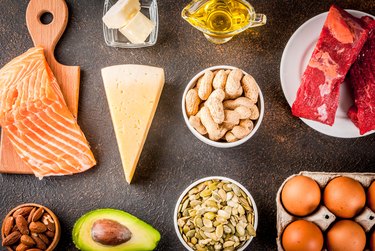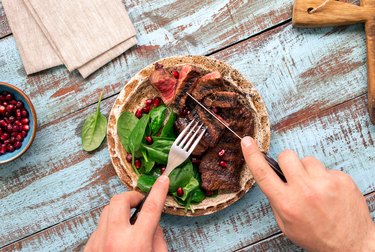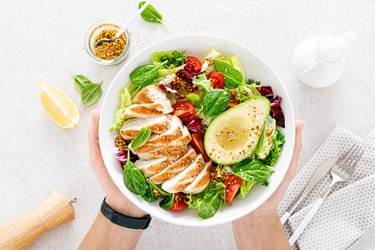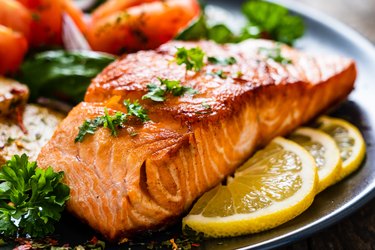
Whether you're looking to load up more plates on the bench press, pressing for a faster 5K or just aiming to be able to get up and down from the sofa as you age, protein is essential to your goals.
That's because protein is an essential nutrient, important for way more than just building massive muscle. Adequate protein helps maintain the muscle you have, supports fat loss and is important for fetal development in people who are pregnant, says Crystal Scott, RD, a registered dietitian with Top Nutrition Coaching.
Video of the Day
Video of the Day
To make sure they're getting enough, maybe people want to know how to eat 100 grams of protein a day. But what does that really look like? Keep reading to learn how four super-fit folks pack 90, 100, 120 or more grams of protein into their daily diets. Plus, learn how to calculate how much protein you need and how to get more.
Why You Need Protein
Your body needs protein to maintain and build muscle. The building blocks of protein are amino acids, and not all amino acids can be made by the body — so we need to get them through food. If you don't get these additional amino acids from the protein in food, your body begins to break down other molecules (often in your muscles) to get them.
For people who work out, this can lead to muscle wasting, injuries, illness and "training intolerance," according to 2022 research review from the International Society of Sports Nutrition (ISSN).
According to recent surveys, most people want more protein in their diets: For example, in its 2023 Food and Health Survey, the International Food Information Council found 67 percent of people are trying to get more protein. But Scott says that for many of her clients, it's a struggle to meet their protein goals.
What 100 Grams of Protein Looks Like for 4 Different People
When you're trying to build a daily healthy eating routine, it helps to have real, concrete examples. That's why we asked four fit folks — a vegan powerlifter, a former pro bodybuilder, a top trainer and a champion pole fitness competitor — to share their daily protein intake and a daily food log to show exactly how they reach their gram goals. Here's what eating 100 grams of protein looks like.
1. A Vegan Powerlifter Who Eats 220 Grams of Protein a Day
Think you can't eat a lot of protein — or build a lot of strength — without animal products? Think again: Ryan Stills was the International Powerlifting Federation's Masters World Champ Best Lifter in 2021, and he's a vegan. Stills is the team captain for powerlifting for the Vegan Strong PlantBuilt Team, and he can lift some serious weight: He squats 700 pounds, can bench press 457 pounds and deadlifts 793 pounds.
Stills competes at 264.5 pounds, and aims for 1 gram of protein per pound of lean body weight — about 220 grams per day.
"When I ate meat, it seemed that number needed to be higher: I was closer to 1.25 to 1.5 grams of protein to every pound of lean mass," he says. But he feels he can eat a little less, he says, with plant sources, leaving more room for carbs to fuel his training. "If I am eating less than 1 gram, though, I don't feel as overall satiated."
Here's a typical day of Stills' eating that gets him more than 200 grams of protein:
220 Grams of Vegan Protein a Day
Contents | Protein Amount | |
|---|---|---|
Meal 1 | Pea protein shake and banana with peanut butter | 60g |
Meal 2 | Pea protein shake and falafel with hummus | 50g |
Snack 1 | Peanut butter and jelly sandwich | 20g |
Meal 3 | Double Impossible or tempeh burger | 50g |
Snack 2 | Protein cereal with almond and cashew milk | 40g |
2. A Pole Sport Champion Who Eats 91 Grams of Protein a Day
Fiona Caffin competes in competitive pole dancing, an acrobatic discipline that requires serious strength: Competitors hold themselves upside down, spin around in the air and perform more acrobatic feats on the pole. Caffin is the founder of Poledance Directory, a site where others can connect with studios and competition in the sport, and a two-time Australian champion.
To support her acrobatics after age 50, Caffin eats 1.6 grams of protein per kilogram of body weight (0.7 grams per pound).
"[That amount] is manageable without going to extremes. It definitely feels like it is feeding my body what it needs," she says. "I'm rarely hungry, feel satisfied after meals and most importantly ... have been seeing strength improvements."
Caffin weighs 125 pounds (57 kilograms), so she's getting 91 grams per day. She says she nearly hits that number with her meals, with vegetables and the soy milk in her coffee topping things off. Here's a typical day:
91 Grams of Protein a Day
Contents | Protein Amount | |
|---|---|---|
Breakfast | Rolled oats with soy milk and coconut yogurt | 11g |
Snack | Satay tofu with caro-gel, a coffee substitute with soy milk and gelatin | 20g |
Lunch | Shrimp and vegetables | 24g |
Dinner | Her daughter’s kangaroo meat recipe (yes, really!) with soy sauce, garlic and vegetables | 28g |
3. A Top Trainer Who Eats 120+ Grams of Protein a Day
John Peel, a trainer for iFit and Nordic Track, doesn't eat as much beef as he did while playing wide receiver at the University of Utah. But the 37-year-old wants to maintain the muscle he's built on his 180-pound frame.
"I've found that 180 to 185 pounds for me is an optimal weight to maintain my strength, but also allows me to stay limber enough to be athletic or run casually," he says. To maintain that weight, he aims for 120 to 150 grams of protein per day.
"It may sound like a lot, but when broken up with protein shakes (each containing about 30 grams of protein) two times a day, I'm able to hit right in that ballpark. I try to have about a fistful of protein with all three meals outside of my shakes."
Here's how he does it:
120+ Grams of Protein a Day
Contents | Protein Amount | |
|---|---|---|
Snack | Protein shake with almond milk | 30g |
Breakfast | Five egg whites, vegetables, ground turkey and avocado | ~30g |
Lunch | Grilled chicken salad, apple with peanut butter | 20 to 30g |
Snack | Protein shake with almond milk | 30g |
Dinner | Ground turkey, sweet potato, black beans, Greek yogurt (as a substitute for sour cream), sriracha | ~30g |
4. A Pro Bodybuilder Who Eats 135+ Grams of Protein a Day
Alina Eisenhauer offers classes on healthy cooking and gluten-free baking and has owned restaurants and bread companies. But she knows a thing or two about fitness, too: Eisenhauer is a competing pro in the masters bikini division for the World Natural Bodybuilding Federation (WNBF).
Most of the time, Eisenhauer aims for 135 grams of protein per day — about 1 gram per pound of her body weight. She'll reach that number eating many of her own high-protein recipes: Her baked protein oatmeal, for example, delivers 11 grams per serving at breakfast. Paleo meatballs at lunch clock in at 4 grams of protein per 47-calorie ball.
Eating one gram of protein per pound of body weight helps her feel satiated while fueling her weight training and cardio, Eisenhauer says. When she's preparing for competition, she'll sometimes increase her protein intake, but here's a typical day packing in 142 grams:
135+ Grams of Protein a Day
Contents | Protein Amount | |
|---|---|---|
Meal 1 | Baked Protein Oatmeal (2 servings) with 4 ounces of nonfat Greek yogurt | 33g |
Meal 2 | Cucumber mango salad with 4.5 ounces of grilled chicken | 36g |
Meal 3 | Paleo Meatballs (5 ounces) with one serving of gluten-free rice pasta and 1/2 cup tomato sauce | 32g |
Snack | 10g | |
Meal 5 | Chickpea vegetable coconut curry (1.5 servings) with 4 ounces of shrimp | 31g |
How Much Protein Do You Need Per Day?
You might not be as competitive an athlete as the folks above, but you're probably still wondering about the right amount of protein for you.
Protein consumption starts with your body weight: The Institute of Medicine's recommended dietary allowance (RDA) of protein is 0.8 grams of protein per kilogram of body weight per day (that's around 0.35 grams per pound of body weight).
To calculate that using your body weight, multiply your weight in kilograms by 0.8, or your weight in pounds by 0.35. So if you weigh 180 pounds, your protein RDA is about 65 grams per day. That's equal to a serving of Greek yogurt, 5 ounces of canned tuna, a serving of black beans and about 3 ounces of chicken breast.
According to USDA statistics, most Americans reach the RDA every day. But the ISSN recommends that almost all of us eat more — whether we're elite athletes, regular gym-goers or even less active older adults.
The ISSN suggests starting with more than double the RDA: 1.6 grams per kilogram of body weight per day — about 0.7 grams per pound of body weight. That's about 126 grams of protein a day for a 180-pound adult.
For certain populations, the group's research suggests eating even more:
- Athletes involved in moderate amounts of intense training: 1.2 to 2.0 grams per kilogram of body weight (0.54 to 0.9 grams per pound)
- Athletes involved in high amounts of intense training: 1.7 to 2.2 grams per kilogram of body weight per day (0.7 to 1.0 grams per pound)
- People with training experience who are trying to lose fat: 2.3 to 3.1 grams per kilogram of body weight per day (1.04 to 1.4 grams per pound)
One number that is often discussed in gyms and among bodybuilders is to consume 1 gram per pound of bodyweight.
While this isn't exactly right, it's a good general goal if you're a regular gym-goer, says Shawn Arent, PhD, CSCS, professor and chair of exercise science at the University of South Carolina. And it's simpler than some of the calculations above. "It's easy math for people," he says. "We are a metrically challenged society! This keeps it simple."
And while the ISSN suggests eating your protein in doses of 20 to 40 grams throughout the day, Arent says that standard should be secondary. Work on hitting your daily number first. That's the part most people struggle with, and the metric that will help you most. Once you're consistently getting there, he says, you can worry about optimizing how much you're eating at each sitting.
Good Sources of Protein
Chicken and lean beef are powerful protein sources, of course: Chicken breast, for example, has 32 grams of protein in a 100-gram serving (that's about 3.5 ounces of meat).
But eating more protein doesn't just mean eating more meat. Whether you're just trying to mix it up or want to reduce your meat consumption, try some of these high-protein foods on your quest for 100 or more grams a day:
- Cheese: Protein content varies by type, but certain varieties of cheese, like feta and paneer, are particularly protein-packed. A half-cup serving of paneer has about 20 grams of protein.
- Eggs: There's lots of protein in that little shell! Each large egg has 6.24 grams of the essential nutrient. (That means it would take more than 16 eggs to get to 100 grams!)
- Fish: Fish high in omega-3 fatty acids are good for your heart and help fill your plate with protein. A small grilled salmon filet, for example, packs in about 35 grams of protein.
- Nuts and Seeds: Almonds are one of the most protein-rich nuts, with a half-cup delivering 15 grams. But calories can add up quickly: That half-cup serving of almonds is more than 400 calories. Among snackable seeds, pumpkin seeds stand out: A half-cup delivers about 17 grams of protein.
Ideally, you want to eat a variety of protein-rich foods to reach your 100 grams, so you get all the essential amino acids. A mix of protein sources can also help with your overall health, Scott says. It means a mix of other nutrients, vitamins and minerals in the food you eat — which can mean a healthier you.
4 Easy Strategies to Eat More Protein
Even with so many sources of quality protein, stacking up the grams to reach 100, 150 or more can feel like you've got to eat a lot of food. Scott suggests four simple strategies that can help increase your protein intake without feeling like you're piling your plate with mountains of chicken.
1. Cook Starches in Bone Broth
Instead of using water to make rice, quinoa or other starchy sides, try bone broth, Scott says. Each cup you use will add an extra 10 grams of protein to your meal.
2. Add Cottage Cheese to Eggs
When making scrambled eggs or an omelet, cottage cheese can add a light texture with minimal flavor disruption — and each half-cup you add puts 12 more grams of protein on your plate.
3. Mix Protein Powder Into Greek Yogurt
Vanilla or chocolate protein powder can turn Greek yogurt into a kind of a breakfast pudding, and it's an easy way to add 20 to 30 grams of protein to your morning, Scott says. Check out our favorite whey protein and vegan protein powders.
4. Combine Proteins on a Single Plate
To keep protein from getting monotonous, Scott suggests combining sources on a single plate. "Take two dollops of cottage cheese. Put some ground turkey on that, and have it with some beans," she says. "You've got 40 to 50 grams of protein in that meal, as well as some fiber that will help fill you up."
What Happens if I Eat More?
Eating more protein provides more benefits to your muscle mass, immune health, body composition and more. But after a certain point, the benefits flatten out, Scott says.
"Eating more than 2.5 grams per kilogram doesn't really do anything additional" for muscle mass or fat loss, Scott says. "You hear about bodybuilders consuming 3 grams or more per kilogram. That's not doing anything more [for them]."
Such high levels of protein, she says, may wind up coming at the expense of other nutrients: carbohydrates you'll need to fuel longer workouts, heart- and gut-healthy fiber or healthy fats that can protect against disease and improve overall nutrient absorption.
But if you're able to get the nutrients you need and feel good while eating 2.4 grams per kilogram of body weight (more than 5 grams per pound), that's OK, Scott says. It won't harm you, or your organs.
"One of the biggest misconceptions about protein intake is that eating too much can harm your kidneys," she says. "Unless you have a pre-existing kidney issue, consuming more is not going to hurt."
- ISSN: "ISSN exercise & sports nutrition review update: research & recommendations"
- International Food Information Council: "2023 Food and Health Survey"
- USDA: "What We Eat in America, NHANES 2017-March 2020 Prepandemic"
- USDA: "Chicken, broiler or fryers, breast, skinless, boneless, meat only, cooked, braised"
- USDA: "Eggs, Grade A, Large, egg whole"
- USDA: "Fish, salmon, grilled"
- USDA: "Nuts, almonds"
- Institute of Medicine: "Dietary Reference Intakes for Energy, Carbohydrate, Fiber, Fat, Fatty Acids, Cholesterol, Protein, and Amino Acids"


